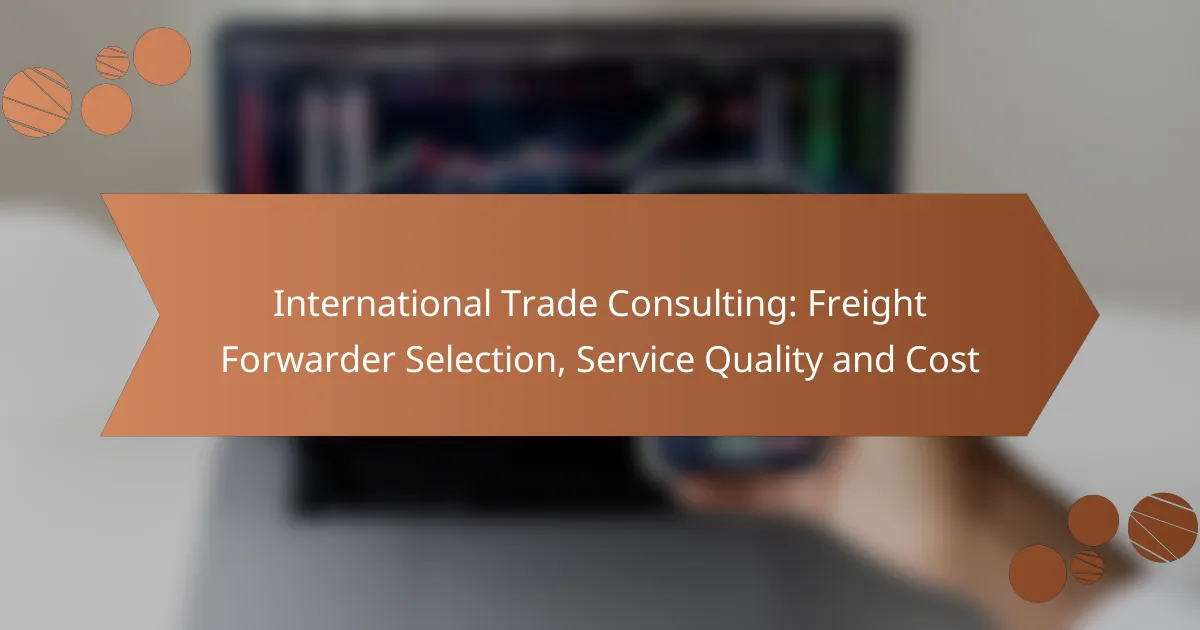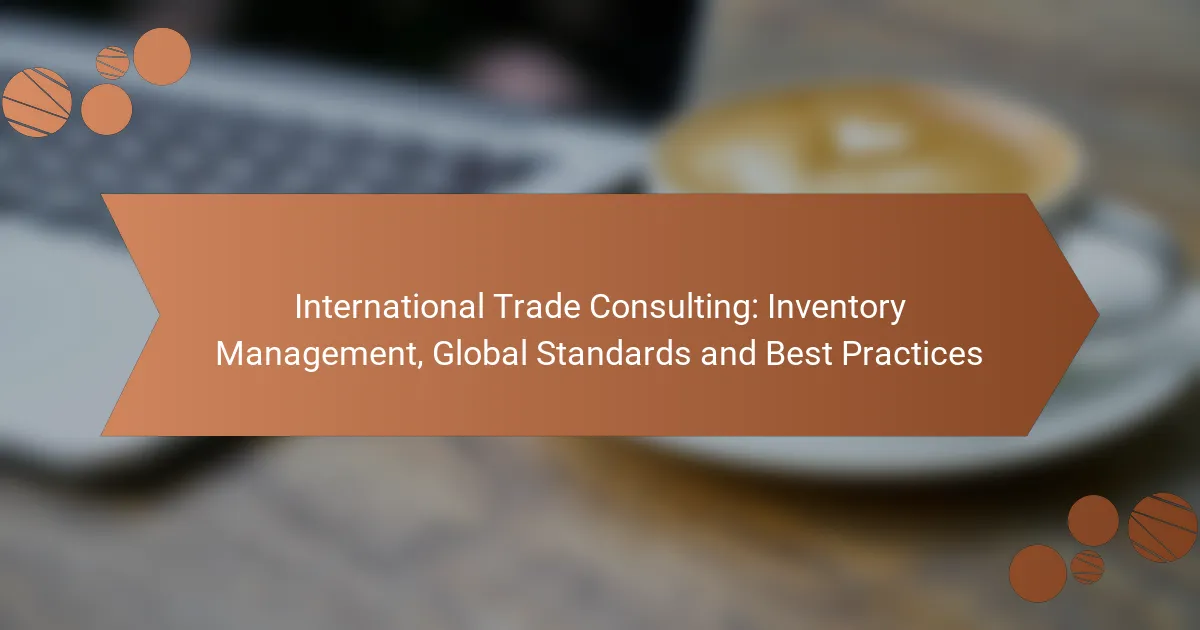Choosing the right freight forwarder is crucial for successful international trade, as it impacts logistics efficiency, cost management, and delivery timelines. Evaluating service quality, industry experience, and customer feedback can guide businesses in making informed decisions. Additionally, understanding pricing structures and potential hidden fees is essential for identifying the most cost-effective solutions while maintaining high service standards.

How to select a freight forwarder for international trade?
Selecting a freight forwarder for international trade involves assessing their service offerings, industry experience, customer reviews, and compliance with regulations. A well-chosen forwarder can streamline logistics, reduce costs, and ensure timely delivery of goods across borders.
Evaluate service offerings
When evaluating service offerings, consider the range of logistics solutions provided by the freight forwarder. Key services may include air and ocean freight, customs clearance, warehousing, and cargo insurance. Ensure that their offerings align with your specific shipping needs and trade routes.
Additionally, inquire about their technology tools for tracking shipments and managing logistics. A forwarder with advanced tracking systems can enhance visibility and communication throughout the shipping process.
Check industry experience
Industry experience is crucial when selecting a freight forwarder. Look for companies that have a proven track record in your specific sector, whether it’s retail, manufacturing, or agriculture. Experienced forwarders are more likely to navigate challenges effectively and provide tailored solutions.
Consider the number of years they have been in business and their familiarity with the countries you are trading with. A forwarder with extensive experience in specific regions can offer insights into local customs and practices that may affect your shipments.
Assess customer reviews
Customer reviews provide valuable insights into a freight forwarder’s reliability and service quality. Look for testimonials on their website and third-party review platforms to gauge overall satisfaction. Pay attention to comments regarding communication, timeliness, and problem resolution.
Additionally, consider reaching out to current or past clients for direct feedback. This can help you understand the forwarder’s strengths and weaknesses, allowing you to make a more informed decision.
Verify compliance with regulations
Compliance with international trade regulations is essential for a freight forwarder. Ensure that they are familiar with customs regulations, trade agreements, and documentation requirements for the countries involved in your shipments. Non-compliance can lead to delays and additional costs.
Check if the forwarder holds necessary certifications, such as IATA for air freight or FMC for ocean freight in the United States. These credentials indicate adherence to industry standards and regulatory requirements, providing peace of mind for your international trade operations.

What factors affect freight forwarding service quality?
Freight forwarding service quality is influenced by several key factors, including timeliness of delivery, communication effectiveness, and handling of goods. Understanding these elements can help businesses select the right freight forwarder and ensure smooth logistics operations.
Timeliness of delivery
Timeliness of delivery is crucial in freight forwarding, as delays can disrupt supply chains and affect customer satisfaction. A reliable freight forwarder should consistently meet agreed-upon delivery schedules, which often range from a few days to several weeks depending on the shipping method and distance.
To evaluate a forwarder’s timeliness, consider their historical performance metrics, such as on-time delivery rates. It’s also beneficial to ask for references from previous clients to gauge their reliability in meeting deadlines.
Communication effectiveness
Effective communication is essential for successful freight forwarding, as it ensures all parties are informed about shipment status, potential delays, and any issues that arise. A good freight forwarder should provide regular updates and be easily reachable through various channels, such as email, phone, or messaging apps.
When assessing communication effectiveness, look for forwarders who offer tracking systems that allow you to monitor shipments in real-time. Clear and timely communication can prevent misunderstandings and enhance overall service quality.
Handling of goods
The handling of goods refers to how freight forwarders manage and transport cargo, which directly impacts the condition of the items upon arrival. Proper handling minimizes the risk of damage, loss, or delays, making it a critical factor in service quality.
To ensure good handling practices, inquire about the forwarder’s experience with specific types of goods, their packaging methods, and compliance with relevant regulations. Additionally, consider whether they have insurance options to cover potential damages during transit.

How to compare freight forwarder costs?
To effectively compare freight forwarder costs, focus on understanding their pricing structures, obtaining detailed quotes, and analyzing any hidden fees. This approach will help you identify the most cost-effective options while ensuring quality service.
Understand pricing structures
Freight forwarders typically use various pricing structures, including flat rates, weight-based rates, and volume-based rates. Flat rates offer predictability, while weight and volume-based rates can vary significantly based on shipment size and type.
It’s essential to understand how each forwarder calculates their costs. Some may include additional services like customs clearance or insurance in their base rate, while others may charge these separately. Knowing these details helps in making accurate comparisons.
Request detailed quotes
When comparing freight forwarders, always request detailed quotes that break down all costs involved. This should include transportation fees, handling charges, and any ancillary services that may apply.
Ensure that the quotes are for the same service level and shipment details to facilitate a fair comparison. Look for quotes that specify transit times and service guarantees, as these factors can significantly impact overall value.
Analyze hidden fees
Hidden fees can significantly inflate the total cost of freight forwarding. Common hidden charges include fuel surcharges, documentation fees, and customs clearance costs. Always ask for a comprehensive list of potential additional charges.
To avoid surprises, read the fine print in contracts and agreements. Some forwarders may have policies that lead to unexpected costs, such as storage fees for delayed pickups or additional charges for changes in shipment details.

What are the key performance indicators for freight forwarders?
Key performance indicators (KPIs) for freight forwarders include metrics that assess their efficiency, reliability, and service quality. These indicators help businesses evaluate potential partners and ensure they meet shipping needs effectively.
On-time delivery rate
The on-time delivery rate measures the percentage of shipments that arrive at their destination as scheduled. A high on-time delivery rate, typically above 90%, indicates a reliable freight forwarder. This metric is crucial for businesses that rely on timely deliveries to maintain operations and customer satisfaction.
To assess this KPI, consider tracking the forwarder’s performance over several months. Look for patterns or fluctuations that might indicate potential issues, such as seasonal delays or disruptions in specific routes. Establishing clear expectations and communication with your forwarder can also help improve this rate.
Damage and loss rates
Damage and loss rates reflect the frequency of shipments that arrive damaged or are lost in transit. A low damage rate, ideally in the low single digits, is essential for maintaining product integrity and customer trust. High damage or loss rates can lead to increased costs and dissatisfaction.
When evaluating this KPI, review the forwarder’s historical performance and any claims filed for damaged or lost goods. It’s also beneficial to understand their packaging standards and handling procedures, as these can significantly impact the likelihood of damage during transit. Regularly discussing these metrics with your forwarder can help identify areas for improvement.

What are the benefits of using a freight forwarder in the USA?
Using a freight forwarder in the USA offers significant advantages, including streamlined logistics, cost savings, and expert guidance through complex shipping processes. They manage transportation, documentation, and customs clearance, allowing businesses to focus on their core operations.
Expertise in customs regulations
Freight forwarders possess in-depth knowledge of U.S. customs regulations, which can be intricate and vary by product type. They ensure compliance with all legal requirements, reducing the risk of delays or penalties. This expertise helps businesses navigate the complexities of tariffs, duties, and import/export restrictions.
For example, a freight forwarder can assist in classifying goods correctly under the Harmonized Tariff Schedule, which is crucial for determining applicable duties. They also stay updated on changes in regulations, ensuring that shipments meet current standards.
Access to global networks
Freight forwarders have established relationships with carriers, customs officials, and other logistics providers worldwide. This network enables them to secure better rates and faster transit times than individual businesses might achieve on their own. They can also provide alternative shipping options, such as air, sea, or rail, based on cost and urgency.
Additionally, their global presence allows for seamless coordination of shipments across borders, minimizing the risk of disruptions. For instance, a freight forwarder can quickly reroute shipments in case of unforeseen events, ensuring timely delivery to customers.

How can technology improve freight forwarding services?
Technology enhances freight forwarding services by streamlining operations, improving visibility, and reducing costs. By leveraging digital tools, freight forwarders can optimize logistics, track shipments in real-time, and automate various processes.
Automation in Freight Forwarding
Automation significantly reduces manual tasks in freight forwarding, leading to increased efficiency. For example, automated booking systems can handle shipment requests without human intervention, allowing for quicker response times and fewer errors.
Additionally, automation can facilitate document management, ensuring that all necessary paperwork is processed accurately and promptly. This not only speeds up operations but also minimizes the risk of compliance issues with customs regulations.
Real-Time Tracking and Visibility
Real-time tracking technology provides visibility throughout the shipping process, allowing businesses to monitor their goods at every stage. This transparency helps companies make informed decisions, such as adjusting delivery schedules based on current shipment status.
Many freight forwarders now offer tracking platforms that provide updates via mobile apps or web portals, enhancing customer experience. Clients can receive notifications about delays or changes, which helps in managing expectations and planning accordingly.
Data Analytics for Decision-Making
Data analytics plays a crucial role in improving freight forwarding services by enabling better decision-making. By analyzing shipping patterns, costs, and performance metrics, companies can identify inefficiencies and optimize their logistics strategies.
For instance, data can reveal the most cost-effective shipping routes or highlight areas where service quality can be improved. This insight allows businesses to make strategic adjustments that enhance overall operational effectiveness.
Cost Reduction through Technology
Implementing technology in freight forwarding can lead to significant cost reductions. Automated systems reduce labor costs, while data analytics help identify less expensive shipping options, ultimately lowering transportation expenses.
Moreover, technology can minimize delays and improve inventory management, which further contributes to cost savings. Companies that invest in these technologies often see a return on investment within a few months due to enhanced efficiency and reduced operational costs.



